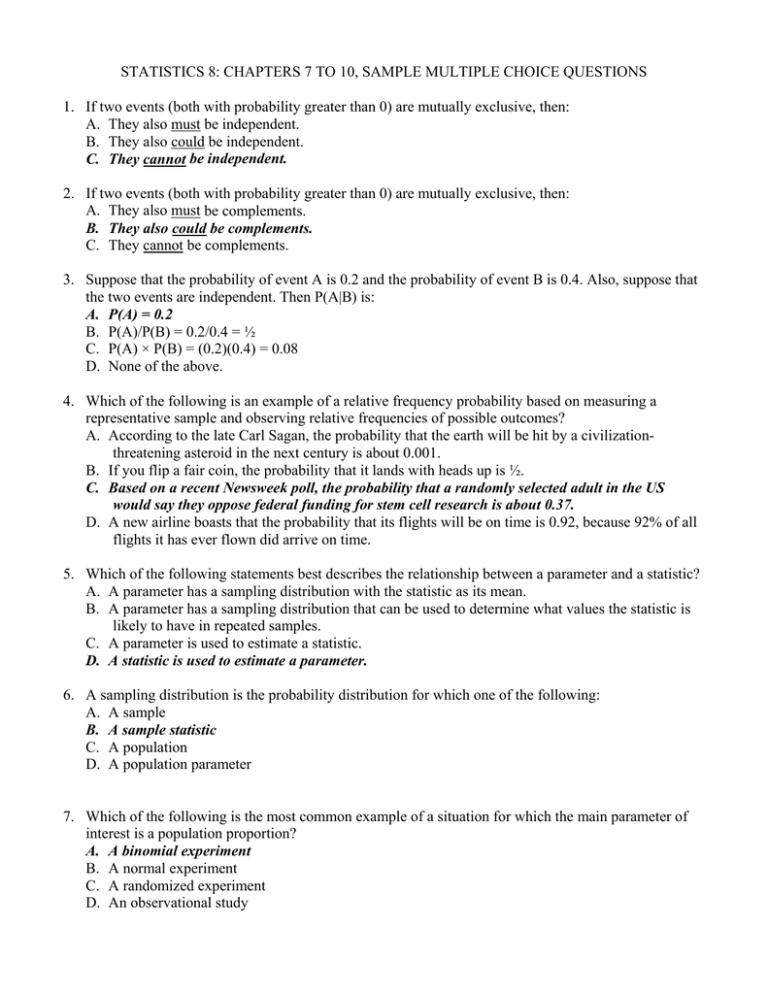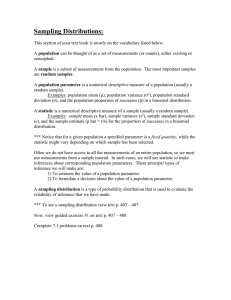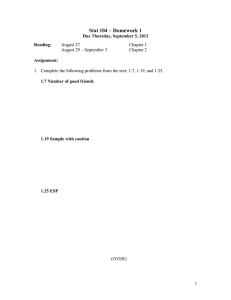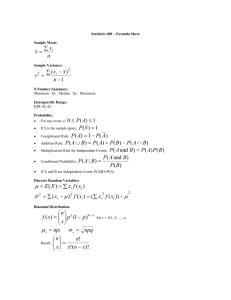statistics 8: chapters 7 to 10, sample multiple choice questions
advertisement

STATISTICS 8: CHAPTERS 7 TO 10, SAMPLE MULTIPLE CHOICE QUESTIONS 1. If two events (both with probability greater than 0) are mutually exclusive, then: A. They also must be independent. B. They also could be independent. C. They cannot be independent. 2. If two events (both with probability greater than 0) are mutually exclusive, then: A. They also must be complements. B. They also could be complements. C. They cannot be complements. 3. Suppose that the probability of event A is 0.2 and the probability of event B is 0.4. Also, suppose that the two events are independent. Then P(A|B) is: A. P(A) = 0.2 B. P(A)/P(B) = 0.2/0.4 = ½ C. P(A) × P(B) = (0.2)(0.4) = 0.08 D. None of the above. 4. Which of the following is an example of a relative frequency probability based on measuring a representative sample and observing relative frequencies of possible outcomes? A. According to the late Carl Sagan, the probability that the earth will be hit by a civilizationthreatening asteroid in the next century is about 0.001. B. If you flip a fair coin, the probability that it lands with heads up is ½. C. Based on a recent Newsweek poll, the probability that a randomly selected adult in the US would say they oppose federal funding for stem cell research is about 0.37. D. A new airline boasts that the probability that its flights will be on time is 0.92, because 92% of all flights it has ever flown did arrive on time. 5. Which of the following statements best describes the relationship between a parameter and a statistic? A. A parameter has a sampling distribution with the statistic as its mean. B. A parameter has a sampling distribution that can be used to determine what values the statistic is likely to have in repeated samples. C. A parameter is used to estimate a statistic. D. A statistic is used to estimate a parameter. 6. A sampling distribution is the probability distribution for which one of the following: A. A sample B. A sample statistic C. A population D. A population parameter 7. Which of the following is the most common example of a situation for which the main parameter of interest is a population proportion? A. A binomial experiment B. A normal experiment C. A randomized experiment D. An observational study 8. Which statement is not true about confidence intervals? A. A confidence interval is an interval of values computed from sample data that is likely to include the true population value. B. An approximate formula for a 95% confidence interval is sample estimate ± margin of error. C. A confidence interval between 20% and 40% means that the population proportion lies between 20% and 40%. D. A 99% confidence interval procedure has a higher probability of producing intervals that will include the population parameter than a 95% confidence interval procedure. 9. Which statement is not true about the 95% confidence level? A. Confidence intervals computed by using the same procedure will include the true population value for 95% of all possible random samples taken from the population. B. The procedure that is used to determine the confidence interval will provide an interval that includes the population parameter with probability of 0.95. C. The probability that the true value of the population parameter falls between the bounds of an already computed confidence interval is roughly 95%. D. If we consider all possible randomly selected samples of the same size from a population, the 95% is the percentage of those samples for which the confidence interval includes the population parameter. 10. In a random sample of 50 men, 40% said they preferred to walk up stairs rather than take the elevator. In a random sample of 40 women, 50% said they preferred the stairs. The difference between the two sample proportions (men – women) is to be calculated. Which of the following choices correctly denotes the difference between the two sample proportions that is desired? A. p1 − p 2 = 0.10 B. pˆ 1 − pˆ 2 = 0.10 C. p1 − p 2 = −0.10 D. pˆ 1 − pˆ 2 = −0.10 <-Correct answer 11. Which of the following statements is correct about a parameter and a statistic associated with repeated random samples of the same size from the same population? A. Values of a parameter will vary from sample to sample but values of a statistic will not. B. Values of both a parameter and a statistic may vary from sample to sample. C. Values of a parameter will vary according to the sampling distribution for that parameter. D. Values of a statistic will vary according to the sampling distribution for that statistic. 12. Five hundred (500) random samples of size n=900 are taken from a large population in which 10% are left-handed. The proportion of the sample that is left-handed is found for each sample and a histogram of these 500 proportions is drawn. Which interval covers the range into which about 68% of the values in the histogram will fall? A. .1 ± .010 B. .1 ± .0134 C. .1 ± .0167 D. .1 ± .020 13. A randomly selected sample of 400 students at a university with 15-week semesters was asked whether or not they think the semester should be shortened to 14 weeks (with longer classes). Fortysix percent (46%) of the 400 students surveyed answered "yes." Which one of the following statements about the number 46% is correct? A. It is a sample statistic. B. It is a population parameter. C. It is a margin of error. D. It is a standard error. 14. Which of the following examples involves paired data? A. A study compared the average number of courses taken by a random sample of 100 freshmen at a university with the average number of courses taken by a separate random sample of 100 freshmen at a community college. B. A group of 100 students were randomly assigned to receive vitamin C (50 students) or a placebo (50 students). The groups were followed for 2 weeks and the proportions with colds were compared. C. A group of 50 students had their blood pressures measured before and after watching a movie containing violence. The mean blood pressure before the movie was compared with the mean pressure after the movie. D. None of the above. 15. A poll is done to estimate the proportion of adult Americans who like their jobs. The poll is based on a random sample of 400 individuals. What is the “conservative” margin of error of this poll? A. 0.10 B. 0.05 C. 0.04 D. 0.025 16. The expected value of a random variable is the A. value that has the highest probability of occurring. B. mean value over an infinite number of observations of the variable. C. largest value that will ever occur. D. most common value over an infinite number of observations of the variable. 17. The payoff (X) for a lottery game has the following probability distribution. X = payoff $0 $5 probability 0.8 0.2 A. B. C. D. E. What is the expected value of X= payoff? $0 $0.50 $1.00 $2.50 18. Which one of these variables is a continuous random variable? A. The time it takes a randomly selected student to complete an exam. B. The number of tattoos a randomly selected person has. C. The number of women taller than 68 inches in a random sample of 5 women. D. The number of correct guesses on a multiple choice test. 19. Heights of college women have a distribution that can be approximated by a normal curve with a mean of 65 inches and a standard deviation equal to 3 inches. About what proportion of college women are between 65 and 67 inches tall? A. 0.75 B. 0.50 C. 0.25 D. 0.17 20. Which one of these variables is a binomial random variable? A. time it takes a randomly selected student to complete a multiple choice exam B. number of textbooks a randomly selected student bought this term C. number of women taller than 68 inches in a random sample of 5 women D. number of CDs a randomly selected person owns 21. Suppose that vehicle speeds at an interstate location have a normal distribution with a mean equal to 70 mph and standard deviation equal to 8 mph. What is the z-score for a speed of 64 mph? A. −0.75 B. +0.75 C. −6 D. +6 22. Pulse rates of adult men are approximately normal with a mean of 70 and a standard deviation of 8. Which choice correctly describes how to find the proportion of men that have a pulse rate greater than 78? A. Find the area to the left of z = 1 under a standard normal curve. B. Find the area between z = −1 and z = 1 under a standard normal curve. C. Find the area to the right of z =1 under a standard normal curve. D. Find the area to the right of z = −1 under a standard normal curve. 23. The probability is p = 0.80 that a patient with a certain disease will be successfully treated with a new medical treatment. Suppose that the treatment is used on 40 patients. What is the "expected value" of the number of patients who are successfully treated? A. 40 B. 20 C. 8 D. 32 24. Suppose that a quiz consists of 20 True-False questions. A student hasn't studied for the exam and will just randomly guesses at all answers (with True and False equally likely). How would you find the probability that the student will get 8 or fewer answers correct? A. Find the probability that X=8 in a binomial distribution with n = 20 and p=0.5. B. Find the area between 0 and 8 in a uniform distribution that goes from 0 to 20. C. Find the probability that X=8 for a normal distribution with mean of 10 and standard deviation of 5. D. Find the cumulative probability for 8 in a binomial distribution with n = 20 and p = 0.5. 25. The normal approximation to the binomial distribution is most useful for finding which of the following? A. The probability P(X = k) when X is a binomial random variable with large n. B. The probability P(X ≤ k) when X is a binomial random variable with large n. C. The probability P(X = k) when X is a normal random variable with small n. D. The probability P(X ≤ k) when X is a normal random variable with small n. 26. A lottery ticket displays the probabilities of winning various prizes on the back of the ticket. These probabilities are examples of: A. Relative frequency probabilities based on long-run observation. B. Relative frequency probabilities based on physical assumptions. C. Personal probabilities. D. Random probabilities. 27. A climate expert was asked to assess the probability that global warming will make some cities uninhabitable in the next 100 years. The answer to this question for the expert is an example of: A. A relative frequency probability based on long-run observation. B. A relative frequency probability based on physical assumptions. C. A random probability. D. A personal probability. 28. Imagine a test for a certain disease. Suppose the probability of a positive test result is .95 if someone has the disease, but the probability is only .08 that someone has the disease if his or her test result was positive. A patient receives a positive test, and the doctor tells him that he is very likely to have the disease. The doctor's response is: A. An example of "Confusion of the inverse." B. An example of the "Law of small numbers." C. An example of "The gambler's fallacy." D. Correct, because the test is 95% accurate when someone has the disease. 29. Which one of the following probabilities is a "cumulative" probability? A. The probability that there are exactly 4 people with Type O+ blood in a sample of 10 people. B. The probability of exactly 3 heads in 6 flips of a coin. C. The probability that the accumulated annual rainfall in a certain city next year, rounded to the nearest inch, will be 18 inches. D. The probability that a randomly selected woman's height is 67 inches or less. 30. A medical treatment has a success rate of .8. Two patients will be treated with this treatment. Assuming the results are independent for the two patients, what is the probability that neither one of them will be successfully cured? A. .5 B. .36 C. .2 D. .04 (this is (1 – .8)(1 – .8) = (.2)(.2) = .04)


